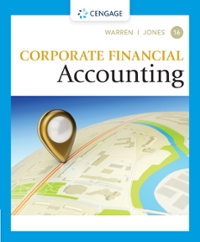Question
Aztec Company sells its product for $170 per unit. Its actual and budgeted sales follow. Units Dollars April (actual) 5,000 $ 850,000 May (actual) 2,000
Aztec Company sells its product for $170 per unit. Its actual and budgeted sales follow.
Units
Dollars
April (actual)
5,000
$
850,000
May (actual)
2,000
340,000
June (budgeted)
5,500
935,000
July (budgeted)
4,500
934,000
August (budgeted)
4,000
680,000
All sales are on credit. Recent experience shows that 26% of credit sales is collected in the month of the sale, 44% in the month after the sale, 27% in the second month after the sale, and 3% proves to be uncollectible. The product's purchase price is $110 per unit. 60% of purchases made in a month is paid in that month and the other 40% is paid in the next month. The company has a policy to maintain an ending monthly inventory of 24% of the next month's unit sales plus a safety stock of 110 units. The April 30 and May 31 actual inventory levels are consistent with this policy. Selling and administrative expenses for the year are $1,260,000 and are paid evenly throughout the year in cash. The company's minimum cash balance at month-end is $110,000. This minimum is maintained, if necessary, by borrowing cash from the bank. If the balance exceeds $110,000, the company repays as much of the loan as it can without going below the minimum. This type of loan carries an annual 13% interest rate. On May 31, the loan balance is $32,500, and the company's cash balance is $110,000.
Required:
1.a schedule that shows the computation of cash collections of its credit sales (accounts receivable) in each of the months of June and July.
2. a schedule that shows the computation of budgeted ending inventories (in units) for April, May, June, and July.
3.the merchandise purchases budget for May, June, and July. Report calculations in units and then show the dollar amount of purchases for each month.
4.a schedule showing the computation of cash payments for product purchases for June and July.
5.a cash budget for June and July, including any loan activity and interest expense. Compute the loan balance at the end of each month.
a schedule showing the computation of cash payments for product purchases for June and July.
Cash payments on product purchases (for June and July)
------------------ Percent Paid in---------------
May
June
July
From purchases in:
May
60%
40%
June
60%
40%
July
60%
------------------ Amount Paid in---------------
Total
May
June
July
From purchases in:
May
$232,100
$139,260
$92,840
June
562,100
337,260
224,840
July
507,100
304,260
$139,260
$430,100
$529,100
a cash budget for June and July, including any loan activity and interest expense. Compute the loan balance at the end of each month.(Do not round intermediate calculations. Negative balances and Loan repayment amounts (if any) should be indicated with minus sign. Round your final answers to the nearest whole dollar value.)
AZTEC COMPANY
Cash Budget
June and July
June
July
Beginning cash balance
$110,000
$110,000
Cash receipts from customers
Total cash available
Cash payments for:
Purchases
Selling and administrative expenses
Interest expense
Total cash payments
0
0
Preliminary cash balance
Additional loan (loan repayment)
Ending cash balance
$0
$0
Loan balance
June
July
Loan balance - Beginning of month
Additional loan (loan repayment)
Loan balance - End of month
Step by Step Solution
There are 3 Steps involved in it
Step: 1

Get Instant Access to Expert-Tailored Solutions
See step-by-step solutions with expert insights and AI powered tools for academic success
Step: 2

Step: 3

Ace Your Homework with AI
Get the answers you need in no time with our AI-driven, step-by-step assistance
Get Started


